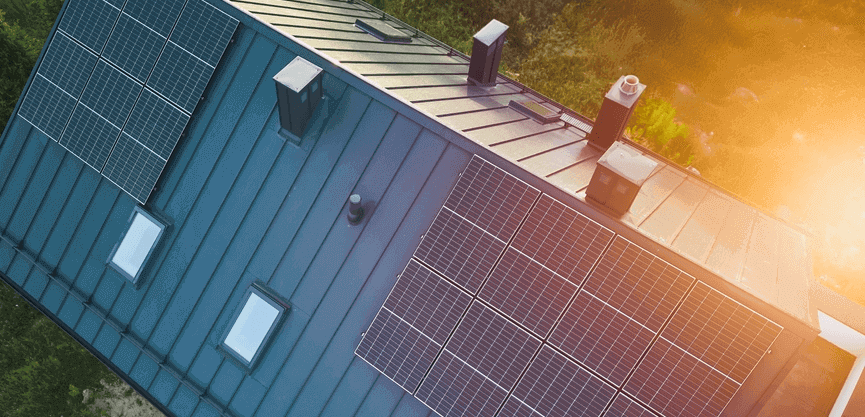KEY POINTS
- On average, a 1kW solar panel array can typically produce between 3.5kWh and 5kWh of electricity per day.
- How much energy your solar panels produce depends on their angle and orientation, how much sunlight and the amount of shading they are exposed to.
- To increase their output, consider replacing them with more efficient types, adding more panels, frequently cleaning them and installing a power usage monitor.
Whether you are looking to rely less on grid electricity or are just trying to reduce your energy bill, knowing how much energy your solar panels produce can help you to make the most out of your solar system.
This Canstar Blue guide compares the amount of energy a solar panel can produce. We’ve also provided some helpful tips for improving efficiency and highlighted what could be impacting the output of your panels.
On this page:
Advertisement
How much energy do solar panels produce?
The amount of energy that a solar panel can produce will vary depending on several factors. According to the Department of Climate Change, Energy, the Environment and Water, 1kW of solar panels can produce between 3.5kWh and 5kWh of electricity a day, on average.
For context, the CSIRO found that the average electricity use per day in Australian households is between 17-20kWh, although may be lower for single person homes.
Average solar panel output per day in Australia
← Mobile/tablet users, scroll sideways to view full table →
| City | 1kW | 1.5kW | 2.0kW | 3.0kW | 4.0kW |
|---|---|---|---|---|---|
| Hobart | 3.5kWh | 5.25kWh | 7.0kWh | 10.5kWh | 14.0kWh |
| Melbourne | 3.6kWh | 5.4kWh | 7.2kWh | 10.8kWh | 14.4kWh |
| Sydney | 4.0kWh | 6.0kWh | 8.0kWh | 12.0kWh | 16.0kWh |
| Adelaide | 4.2kWh | 6.3kWh | 8.4kWh | 12.6kWh | 16.8kWh |
| Brisbane | 4.2kWh | 6.3kWh | 8.4kWh | 12.6kWh | 16.8kWh |
| Cairns | 4.2kWh | 6.3kWh | 8.4kWh | 12.6kWh | 16.8kWh |
| Canberra | 4.3kWh | 6.45kWh | 8.6kWh | 12.9kWh | 17.2kWh |
| Darwin | 4.4kWh | 6.6kWh | 8.8kWh | 13.2kWh | 17.6kWh |
| Perth | 4.4kWh | 6.6kWh | 8.8kWh | 13.2kWh | 17.6kWh |
| Alice Springs | 5.0kWh | 7.5kWh | 10.0kWh | 15.0kWh | 20.0kWh |
Source: Australian Government, DCCEEW. Average daily production of solar PV cells in Australia.
As depicted in the table above, location and climate play a large role in the average solar panel output. Households in warmer, sunnier areas such as Alice Springs, Darwin and Perth can clearly benefit from a higher energy output on their solar panels. Residents in Hobart and Melbourne will likely see less solar power generated from their system, due to the cooler, shadier weather conditions.
How is a solar panel’s output measured?
The size of a solar panel’s generational capacity and its expected output are measured using different scales. Typically, solar panel sizing is measured in Watts (W) or kilowatts (kW), whereas a panel’s output is measured in kilowatt hours (kWh).
It is important to note that while these measurements are related, they are not interchangeable. For example, if you install a 4kW solar panel, this does not necessarily mean that your system will only generate 4kWh of energy a day. It simply means that this is the size of the generation system within your solar panel.
What factors impact a solar panel’s output?
Aside from the obvious factor of the panel size, there are a few other elements that can influence the yield from your system. Some of these include:
- The angle, tilt and orientation at which your solar panels have been installed.
- The number of daylight hours in the area you reside in.
- The surrounding landscape and any shading or intrusions near the panels.
- The intensity of the sunlight in your area.
- The number of cloudy days in comparison to sunny days.
While some of these factors may be out of your control, keeping them in mind when choosing where to install your solar panels could help to improve their efficiency and how much power the solar panels produce.
Solar plans and prices
Here are some of the cheapest solar-specific deals from the retailers on our database. These costs are based on the Ausgrid network in Sydney but prices will vary depending on your circumstances. We show one product per retailer, listed in order of lowest price first. Annual price estimates assume general energy usage of 3900kWh/year for a residential customer on a single rate tariff. Price estimates exclude solar feed-in tariff credits. These are products from referral partners†. Our database may not cover all deals in your area, and please check retailer websites for up to date information.
Here are some of the cheapest solar-specific deals from the retailers on our database. These costs are based on the Citipower network in Melbourne but prices will vary depending on your circumstances. We show one product per retailer, listed in order of lowest price first. Annual price estimates assume general energy usage of 4000kWh/year for a residential customer on a single rate tariff. Price estimates exclude solar feed-in tariff credits. These are products from referral partners†. Our database may not cover all deals in your area, and please check retailer websites for up to date information.
Here are some of the cheapest solar-specific deals from the retailers on our database. These costs are based on the Energex network in Brisbane but prices will vary depending on your circumstances. We show one product per retailer, listed in order of lowest price first. Annual price estimates assume general energy usage of 4600kWh/year for a residential customer on a single rate tariff. Price estimates exclude solar feed-in tariff credits. These are products from referral partners†. Our database may not cover all deals in your area, and please check retailer websites for up to date information.
Here are some of the cheapest solar-specific deals from the retailers on our database. These costs are based on SA Power network in Adelaide but prices will vary depending on your circumstances. We show one product per retailer, listed in order of lowest price first. Annual price estimates assume general energy usage of 4000kWh/year for a residential customer on a single rate tariff. Price estimates exclude solar feed-in tariff credits. These are products from referral partners†. Our database may not cover all deals in your area, and please check retailer websites for up to date information.
4 ways to improve how much power your solar panels produce
If you are concerned about the output from your solar panels, there are a few things you can do to try and maximise how much power your solar panels produce.
1. Install a more efficient solar panel type
Some solar panel types are considered to be more efficient than others, due to factors such as increased surface area or the number of cells included in the panel size. Generally, solar panels that are made from monocrystalline are regarded as a more efficient solar panel type. This is because monocrystalline panels are created from a single source of silicon, as opposed to other panel types, such as polycrystalline, which use a blended silicon. Keep in mind that monocrystalline solar panels typically come with a higher price tag than other solar panel types, so it may be worth considering whether the potential for more output will outweigh the additional upfront costs.
2. Consider adding more solar panels to your system
If you are looking to expand the power capacity of your solar system, then it may be worthwhile adding more solar panels to your rooftop. However, there are quite a few things to consider before expanding your solar system. Firstly, you’ll need to ensure that your solar inverter can support additional solar panels. Solar inverters can ‘oversize’ their capacity by approximately 133 per cent, but they cannot support any more than this. As such, if your solar system is already at its capacity, adding additional solar panels may mean you’ll also need to upgrade your solar inverter, which could be costly.
It’s also important to consider the warranty or solar rebates currently available on your current solar system before expanding. Some warranties or government-boosted solar feed-in tariffs (FiTs) may become void if the solar system is upgraded before the expiry date.
For more information around adding solar panels to an existing solar system, it’s best to get in touch with a licensed solar professional.
You might also be interested in:
3. Clean your solar panels
By learning how to clean your solar panels and maintain them properly, you may also be able to improve the efficiency and longevity of your solar system. Research from Solar Analytics suggests that dirty solar panels may be responsible for a drop of up to 5% of solar panel energy production (although this could also be caused by other factors such as weather). Scheduling in a clean for your panels could help you to improve the power output of your solar system — but keep in mind that the rain, wind and sun in Australia can help to clean panels naturally.
4. Use solar monitoring technology
If you want to keep track of the output from your solar panels, it may be worthwhile to start utilising solar energy monitoring technology. Most modern solar inverter systems should have a built-in monitoring software set up which can show data, including how much energy your panels have produced over a certain period, how much electricity you use from the electricity grid and even the impact shade has had on certain parts of the solar panels. You can then use this information to see where your solar system might be lacking in terms of efficiency.
If your solar inverter doesn’t have built-in software, you could also look to invest in a third-party app or device to track your solar power output.
How do I decide what solar panel system is right for me?
Picking a home solar system will be based on many factors, from the number of people living at the property to solar energy goals of the household. That’s why it’s important to carry out your research and gather as many quotes as you can before making a purchase decision. There isn’t a one-size-fits-all solution, so finding a quality solar installer that can best work to the energy needs of your home will be key.
Check out Canstar Blue’s annual solar installer ratings below. Here you’ll find a selection of companies that Australian consumers have rated as best for solar installations.
Original reporting by Kelseigh Wrigley
Image Source: alexgo.photography/Shutterstock




Share this article